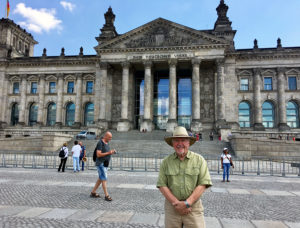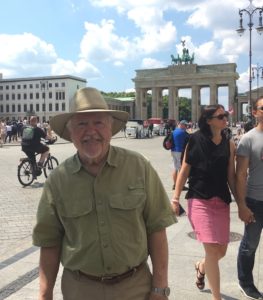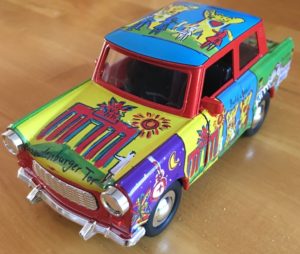Monday, 17 June, was our first huge tourism day in Berlin. We went to the Tiergarten District, which includes the famous zoological garden of the same name and many of the major historic sites of the city.
(To give a sense of scale, the Health app on my iPhone recorded me taking 24,839 steps to cover 8.8 miles and 10 floors that day. Personal record in steps/distance.)
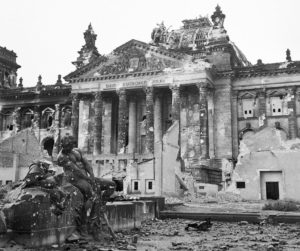
The Reichstag
Our first main stop was the Reichstag, home of the present Bundestag, the German federal parliament. Originally built in 1894 to house the Imperial Diet of the German Empire, the structure was severely damaged in 1933, when it was set on fire in suspicious circumstances. Blaming Communists for the fire, the new Nazi government suspended rights granted the party and arrested members. It was also damaged by Allied bombing of Berlin in WWII.
During the Cold War, the government of West Germany was in Bonn, and the Reichstag went through only a partial restoration. When reunification of German took place in 1990, the official ceremony took place at the Reichstag. It was not until 1999, however, that full restoration of the building was completed. Architect Norman Foster replaced the original cupola with a glass dome that is a particular favorite with tourists.
(Julia and I had intended to visit the dome, but you need to make a reservation and our upcoming week-long trip to Lithuania prevented us from securing one.)
Here’s video (2:01) of the first part of the journey.
Brandenburg Gate
Those of us of a certain age are familiar with the name Brandenburg Gate, as it was a major symbol of the Cold War. It was originally built in 1791 on the order of Prussian King Frederick William II to celebrate the peaceful resolution of conflict with the Dutch.
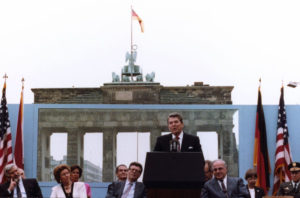 Located just inside what was East Berlin, the gate was closed following the construction of the Berlin Wall. In 1987, U.S. President Ronald Reagan spoke at the gate (photo) and said, “Mr. Gorbachev, open this gate! Mr. Gorbachev, tear down this wall!” The gate was the site of another official event on the day of German reunification. At midnight on 3 October 1990, the West German flag — now the flag of a reunified Germany — was raised over the gate.
Located just inside what was East Berlin, the gate was closed following the construction of the Berlin Wall. In 1987, U.S. President Ronald Reagan spoke at the gate (photo) and said, “Mr. Gorbachev, open this gate! Mr. Gorbachev, tear down this wall!” The gate was the site of another official event on the day of German reunification. At midnight on 3 October 1990, the West German flag — now the flag of a reunified Germany — was raised over the gate.
There is no vehicle traffic through the gate. The adjacent large square — Pariser Platz — is a cobblestone pedestrian zone. The U.S. Embassy is located on the northern edge of Pariser Platz, next to the gate. And we found a little touch of the U.S. there.
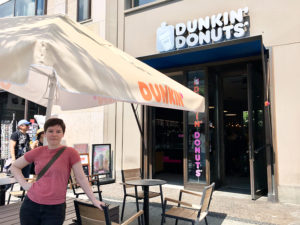
The walk also brought us to the site of the “Memorial for the Uprising of 1953,” something I had not been aware of. The memorial is located in the forecourt of a massive building that had been Hermann Goring’s Ministry for Aviation in the Nazi era and is now the German Department of Finance.
For three days in June 1953, tens of thousands of East Germans took to the streets in East Berlin and in other parts of East Germany in protest against the East German regime. Soviet troops and East German police put down the uprising, at a cost of more than 500 persons killed, 1,800 wounded, and 5,000 arrested.
West Germany established the memorial. The broad avenue through Tiergarten, seen at the beginning of the Reichstag video above, is named “Straße des 17 Juni.”
East Germans had produced an art piece, a mural on the front of the building, entitled “Aufbau der Republik” (Build-up of the Republic). Made of Meissen porcelain tiles and described as an example of “socialist realism,” it depicts happy East Germans toiling in joy in service to the state.
Here is video (2:32) of that area.
Checkpoint Charlie
Another iconic name from post WWII, Checkpoint Charlie was the border crossing point between the Russian and American zones of occupied Berlin immediately after the war and later, following the building of the Berlin Wall, between East and West Germany.
Today, it is a tourist attraction with actors playing the roles of American or Soviet soldiers and shops offering bogus pieces of the Berlin Wall.
Here’s video (1:29).
The Trabant
If West Germany has been famous for the high quality of automobiles designed and built there, East Germany was maybe notorious for producing the Trabant, better known by a nickname, the Trabi.
Called “a spark plug with a roof,” the Trabi was built between 1957 and 1990 with few if any significant variations. It was the most common car in East Germany and, as it was produced by a state monopoly, it took 10 years to get one. Most agreed with the description of the cars as “loud, slow, poorly designed, and badly built.”
Trabis are now something of a retro item, used for displays, toys, etc. This is a toy I brought home for my granddaughters.
During our walkabout this day, I came across what I thought might be a Trabi used car lot. Indeed, it was connected to Trabi World, where one could rent a Trabi for a spin around Berlin. Don’t know what provisions were made for possible breakdowns. Here’s video (1:04).
Potsdamer Platz and The Wall
Potsdamer Platz is about a kilometer south of the Brandenburg Gate. The area was pretty much destroyed during WWII and then left desolate by the East Germans, bisected by the Berlin Wall. Since reunification, it has been transformed into a thriving commercial center.
Here’s video (3:19), including panoramic views of the city.
Holocaust Memorial
On a site covering more than 4.5 acres, located between Potsdamer Platz and the Brandenburg Gate, lie 2,711 slabs of concrete of varying height. They constitute the “Memorial to the Murdered Jews of Europe,” also known as the Holocaust Memorial.
Completed in 2005, the memorial’s design has been controversial. There are no plaques, inscriptions, religious symbols, or names. New York architect Peter Eisenman, who designed the memorial, said he wanted visitors to feel the loss and disorientation that Jews felt during the Holocaust. No stone is the exact same size as another, intended to reflect individuality along with sameness. I guess I appreciate representational art more than conceptual art. Personally, I found the memorial lacking . . . what, I’m not quite sure.
Here’s video (1:02).
Soviet War Memorial
Seemingly out of place, there is a large Soviet War Memorial in Tiergarten. It was erected in 1945, only months after Soviet troops took Berlin, using stones from the destroyed Reich Chancellery.
The site is also the burial place of about 2,000 Soviet soldiers, from among an estimated 80,000 killed in the Battle of Berlin. The memorial is still used for commemorative events, including VE (Victory in Europe) Day, 8 May.
Last video (0:56) for today.

